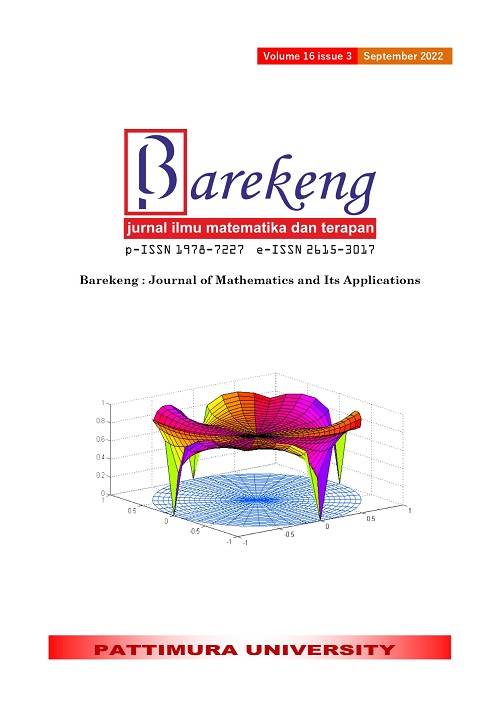SURVIVAL ANALYSIS OF DENGUE HEMORRHAGIC FEVER PATIENTS (DHF)
Abstract
Dengue Hemorrhagic Fever (DHF) is a dangerous disease transmitted by the Dengue virus. In 2020, along with the occurrence of the Covid-19 pandemic in Indonesia, the number of dengue cases in Indonesia was high. One of the provinces recorded as the highest suspected dengue fever area is North Sumatra. This is evidenced in October 2019 North Sumatra became the province with the highest suspected dengue fever in Indonesia with a total of 250 cases. Based on the medical record data of patients with DHF at the Dr. Pirngadi General Hospital, Medan in 2019, the factors thought to affect the rate of survival of DHF patients were age, gender, platelet count, and hematocrit levels. Furthermore, survival analysis was carried out using the Kaplan-Meier method and Cox Proportional Hazard Regression with the suspected factors to determine the estimated survival function for patients with DHF and to determine the factors that affect the recovery rate of patients with DHF. Based on the survival function curve, it was found that the curve decreased slowly because many patients with DHF were censored and it was found that the chances of survival of patients with DHF were relatively high, ranging from 1 to 0.6352. Based on the selection of the best model, it was found that only the age variable had a significant effect on the model.
Downloads
References
KEMENKES RI. (2018, Agustus) Kementerian Kesehatan Republik Indonesia. [Online]. https://www.kemkes.go.id/article/view/18081400001/HEALTH-ADVICE-FOR-TRAVELLER-TO-2018-ASIAN-GAMES-IN-INDONESIA.html
Pemerintah Indonesia, Undang-Undang Republik Indonesia Nomor 36 Tahun 2009 Tentang Kesehatan. Jakarta, Indonesia: Sekretariat Negara, 2009.
MENKES RI, Peraturan Menteri Kesehatan Republik Indonesia Nomor 1501/MENKES/PER/X/2010 Tentang Jenis Penyakit Menular Tertentu yang Dapat Menimbulkan Wabah dan Upaya Penanggulangan. Indonesia: Menteri Kesehatan Republik Indonesia, 2010.
D.P.R. Indriyani and I.W. Gustawan, "Manifestasi Klinis dan Penanganan Demam Berdarah Dengue Grade 1 : Sebuah Tinjauan Pustaka," Jurnal Intisari Sains Medis, vol. 11, pp. 1015 - 1019, 2020.
Frida N, Mengenal Demam Berdarah Dengue. Semarang, Indonesia: Alpirin, 2019.
KEMENKES RI. (2020, Juli) Kementerian Kesehatan RI. [Online]. https://www.kemkes.go.id/article/view/20070900004/hingga-juli-kasus-dbd-di-indonesia-capai-71-ribu.html
Indopos. (2019, November) Indopos.co.id. [Online]. https://indopos.co.id/read/2019/11/05/204756/sumut-suspek-dbd-tertinggi
DINKES PROV.SUMUT, Profil Kesehatan 2013. Sumatera Utara, Indonesia: Dinas Kesehatan Provinsi Sumatera Utara, 2013.
BPS. (2018, November) Badan Pusat Statistik. [Online]. https://sumut.bps.go.id/statictable/2018/11/28/1291/jumlah-kasus-hiv-aids-ims-dbd-diare-tb-dan-malaria-menurut-kabupaten-kota-di-provinsi-sumatera-utara-2017.html
R.Harja. (2019) Medan Bisnis Daily. [Online]. https://medanbisnisdaily.com/m/news/online/read/2019/11/06/91841/hingga_oktober_angka_dbd_di_medan_capai_913_kasus/
KEMENKES RI, Pedoman Pencegahan dan Pengendalian Demam Berdarah Dengue di Indonesia. Jakarta, Indonesia: Kementerian Kesehatan Republik Indonesia, 2017.
Noivia Cycta Hari, Hanny Komalig, and Yohanes A.R Langi, "Analisis Survival dalam Menentukan Faktor-faktor yang Mempengaruhi Lama Studi Mahasiswa Matematika di Jurusan Matematika FMIPA Universitas Sam Ratulangi Manado," Jurnal Matematika dan Aplikasi, vol. 7, pp. 84 - 89, Seotember 2018.
L.E. Widyawati and R.D. Bekti, "Analisis Faktor yang Mempengaruhi Laju Kesembuhan Pasien Demam Berdarah Dengue Menggunakan Regresi Cox Proportional Hazard dan Regresi Weibull (Studi Kasus : Kabupaten Bantul, Yogyakarta)," Jurnal Statistika Industri dan Komputasi, vol. 5, pp. 26 - 36, 2020.
R.G. Miller, Survival Analysis. California: Stanford University, 1998.
J. Harlan, Analisis Survival. Depok, Indonesia: Gunadarma, 2017.
H. Rehman, H. Chandra, and S.R. Jammalamadaka, "Competing Risk Survival Data Under Middle Censoring An Application to COVID-19 Pandemic," Healthcare Analytics Journal, 2021.
T. Dey, A. Mukherjee, and S. Chakraborty, "A Practical Overview and Reporting Strategies for Statistical Analysis of Survival Studies," Journal of Chest, vol. 158, pp. S39 - S48, 2020.
D.G. Kleinbaum and M. Klein, Survival Analysis A Self-Learning Text Second Edition. New York: Springer, 2005.
C. Kartsonaki, "Survival Analysis," Mini-Symposium : Medical Statistics, vol. 22, pp. 263 - 270, 2016.
A.T. Amare et al, "Survival Status and Predictors or Mortality Among Traumatic Brain Injury," African Journal of Emergency Medicine, pp. 396 - 403, 2021.
I.N. Pertiwi and S.W. Purnami, "Regresi Cox Proportional Hazard untuk Analisis Survival Pasien Kanker Otak di C-Tech Labs Edwar Technology Tangerang," Jurnal Inferensi, vol. 3, pp. 2721 - 3862, 2020.
M.R. Pahlevi, M. Mustafid, and T. Wuryandi, "Model Regresi Cox Stratified pada Data Ketahanan," Jurnal Statistika Undip, vol. 5, pp. 455 - 464, 2016.
Copyright (c) 2022 Firza Khairunnisa, Fazrina Saumi, Amelia Amelia

This work is licensed under a Creative Commons Attribution-ShareAlike 4.0 International License.
Authors who publish with this Journal agree to the following terms:
- Author retain copyright and grant the journal right of first publication with the work simultaneously licensed under a creative commons attribution license that allow others to share the work within an acknowledgement of the work’s authorship and initial publication of this journal.
- Authors are able to enter into separate, additional contractual arrangement for the non-exclusive distribution of the journal’s published version of the work (e.g. acknowledgement of its initial publication in this journal).
- Authors are permitted and encouraged to post their work online (e.g. in institutional repositories or on their websites) prior to and during the submission process, as it can lead to productive exchanges, as well as earlier and greater citation of published works.






1.gif)



